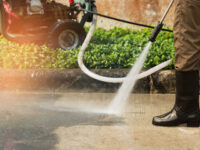Landscaping Tips – How to Prevent Soil Compaction and Increase Soil Fertility
Greensboro Landscaping adds value to your property, makes functional outdoor areas, and improves the environment. It includes design planning, terrain assessment and incorporating structural elements.
Mulching is used to save water, suppress weeds and provide a neat appearance. It also helps rain to penetrate the soil, reduces evaporation and moderates soil temperatures.
Mulching prevents weeds from growing by blocking sunlight to their seeds. This helps to reduce the time and effort needed for weed removal, as well as protecting plants from competition for water and nutrients.
Organic mulches such as leaves, grass clippings, or shredded bark help to improve soil health as they decompose, adding beneficial nutrients and improving the structure of the soil. Inorganic mulches, such as gravel or plastic sheeting, can also be effective if applied at the right thickness and in the right areas.
Many perennial plantings, shrubs and trees benefit from the use of inorganic mulches like landscape fabric. However, these types of mulches can impede rain, air and nutrients from reaching the soil and can cause damage to the root systems of some perennials. Additionally, impermeable plastic sheeting may leach toxic chemicals into the soil over time. For these reasons, organic mulch is the best choice for most applications.
Reduces soil compaction
Soil compaction occurs when soil particles are pressed together, restricting the movement of air, water, and nutrients. This can lead to nutrient deficiencies, stunted growth, and poor drainage. Fortunately, there are ways to prevent soil compaction and increase soil health.
One of the best ways to reduce compaction is by adding organic matter. Organic mulches, such as wood chips or compost, help promote aggregation of soil particles and create a network of pores that allows roots to grow. They also provide a number of other benefits, including moisture retention, temperature regulation, weed control, and erosion control.
Another way to reduce compaction is to minimize foot and machinery traffic in cultivated areas. If this is not possible, consider using a path made of wooden planks or permeable fabric covered in gravel. In addition, core aeration is an effective way to alleviate compaction in lawns and garden beds. This is done by inserting a tool with hollow tines or spoons into the soil. However, this technique is less effective in severely compacted soils.
Reduces soil erosion
Soil erosion is a serious problem that causes loss of fertile topsoil, sedimentation in water bodies, and damage to plants. The best way to prevent soil erosion is by applying mulch. Mulching helps to reduce the impact of rain and wind, which can cause erosion and can lead to poor plant growth. In addition, it also helps to retain moisture and promotes healthier plant growth.
Various experiments have shown that mulching can prevent soil erosion by reducing the amount of energy that is transferred from one area to another. For example, studies have found that erosion rates decrease as stubble height and mulching quantity increase (Lotfalian et al., 2013).
Organic mulches are especially effective in preventing erosion because they help to improve the structure of the soil as they decompose. These types of mulches include garden compost, wood chips, well rotted manure, and leaves. They also help to suppress weeds, which compete with desired plants for nutrients and can contribute to soil erosion. It is important to apply the correct thickness of mulch to avoid affecting the root systems of your plants and to replenish the layer as needed.
Reduces weed growth
Weeds steal water and nutrients from the plants you want to grow, so they are a major garden nuisance. But instead of spraying them into oblivion with chemical herbicides, you can use mulch to discourage their growth.
A layer of organic mulch, such as wood chips, straw, hay or leaves, decomposes over time, enriching the soil with essential nutrients and reducing weed growth. Unlike synthetic or plastic mulches, organic materials encourage the proliferation of beneficial soil organisms, which help break down weed seeds and inhibit their germination.
When used in combination with a pre-emergent herbicide, mulching significantly reduces annual weeds. However, it is not guaranteed to stop all weeds, especially perennial weeds such as nutsedge (Cyperus rotundus).
For the best results, apply mulch in the spring before weeds germinate and before the ground heats up. If you can’t do this, try using a granular pre-emergent, such as prodiamine or pendimethalin. If you use a landscape fabric, tack it down with U-shaped nails before installing the mulch layer. Otherwise, weeds will grow into or through the fabric.
Increases soil fertility
Healthy soil has the potential to provide your plants with essential nutrients, water and oxygen, as well as a thriving ecosystem of beneficial microorganisms. Using proven methods to boost soil fertility, such as adding organic matter and composting, can make all the difference in the health of your garden and landscape. Among these techniques, mulching is one of the most effective.
The addition of organic matter, such as leaves, bark, or compost, has been shown to improve soil structure, and increase its cation exchange capacity (CEC). As it decomposes over time, organic mulch also increases the amount of available nitrogen (ammonium and nitrate) in the soil.
Mulching can also help to maintain optimal soil fertility, reducing the need for synthetic fertilizers. As organic mulch decomposes, it releases valuable nutrients, including nitrogen, phosphorus, and potassium, into the soil. This nutrient cycle provides plants with an essential source of these vital minerals, ensuring healthy growth and reducing the need for chemical fertilizers. Mulching can also reduce the need for watering and prevent the evaporation of soil moisture.
Increases soil aeration
Organic mulches such as compost or wood chips are rich in nutrient content and can enhance soil fertility. However, organic matter can also heat the soil and decrease its aeration. This can cause root rot, fungal diseases and other problems that can weaken or kill bamboo trees. Aerating the soil can reduce these effects and help ensure optimal tree health. Aeration increases the amount of oxygen in the soil, which allows the roots to obtain sufficient energy to grow and survive. Aeration also mitigates the negative effect of hypoxia on plant roots.






